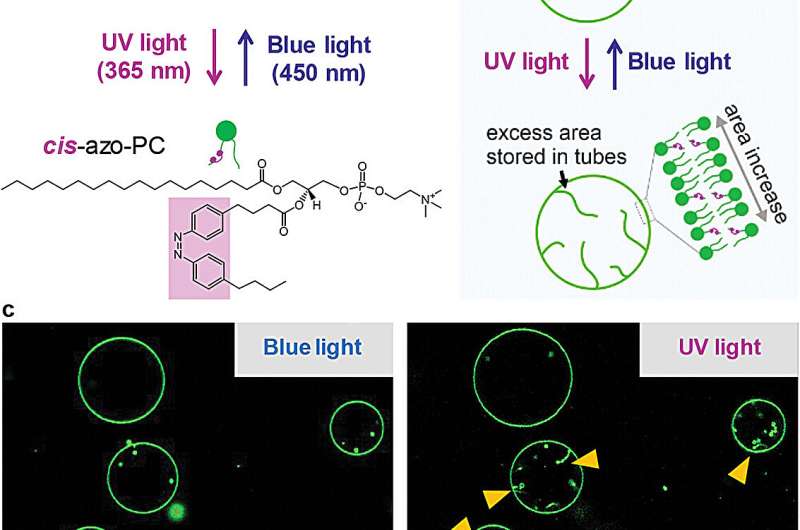This article has been reviewed according to Science X's editorial process and policies. Editors have highlighted the following attributes while ensuring the content's credibility:
fact-checked
peer-reviewed publication
trusted source
proofread
With the flick of a switch: Shaping cells with light

Imagine switching on a light and being able to understand and control the inner dynamics of a cell. This is what the Dimova group has achieved: by shining lights of different colors on replicates of cells, they altered the interactions between cellular elements. Controlling these complex interactions enables us to deliver specific drugs directly into the cells. And with the flick of a switch, we could adjust or even reverse this delivery, potentially revolutionizing the treatment of cells in a smart, accurate and non-invasive way.
Cells are the building blocks of our body and are organized into smaller components, each with a specialized function. Most of these components are enveloped by a protective membrane made of fats, with the exception of the biomolecular condensates. These tiny, dynamic droplets prepare the cell for rapid stress response by gathering and organizing repair molecules (among other functions).
Rumiana Dimova and her team at the Max Planck Institute of Colloids and Interfaces study the many and intricate ways in which condensates interact with membranes, and how they affect each other's shape and structure. In their latest work, published in Advanced Science, the researchers have focused on the process of endocytosis. This is how a cell wraps its outer membrane around nutrients or pathogens to "eat" them.
The researchers designed their own lab-made, simplified versions of cells—called giant vesicles—to simulate the cellular processes and analyze them under the microscope. They introduced fats that react to light ("photoswitchable lipids"). Dimova and her team observed how the membranes behaved when exposed to light of different colors: They changed their size and triggered various interactions with the condensates.
"When we shine ultraviolet light on a membrane, it grows and 'swallows' the condensates,"—explains Agustín Mangiarotti. "And we can also reverse the process by switching to blue light," adds Mina Aleksanyan, "so that the membrane shrinks, expelling the condensate."
The therapeutic potential of this research is immense. The combined use of giant vesicles and light could represent a non-invasive medical treatment to control cellular dynamics.
Light is inexpensive and sustainable. And because giant vesicles are synthetic (made in a lab), scientists can use them to probe several dynamics without resorting to culture cells from living organisms. Giant vesicles are also biomimetic—constructed from molecules found in the human body, such as fats and proteins. They are like tiny capsules that can carry drugs and then fuse organically with cells.
"Now we know that by modulating light we can control how vesicles shape the inner environment of a cell, which could help treat cellular disorders. It's like being able to sculpt a cell from the inside by flicking a light switch," concludes Dimova.
More information: Agustín Mangiarotti et al, Photoswitchable Endocytosis of Biomolecular Condensates in Giant Vesicles, Advanced Science (2024). DOI: 10.1002/advs.202309864
Journal information: Advanced Science
Provided by Max Planck Institute of Colloids and Interfaces





















